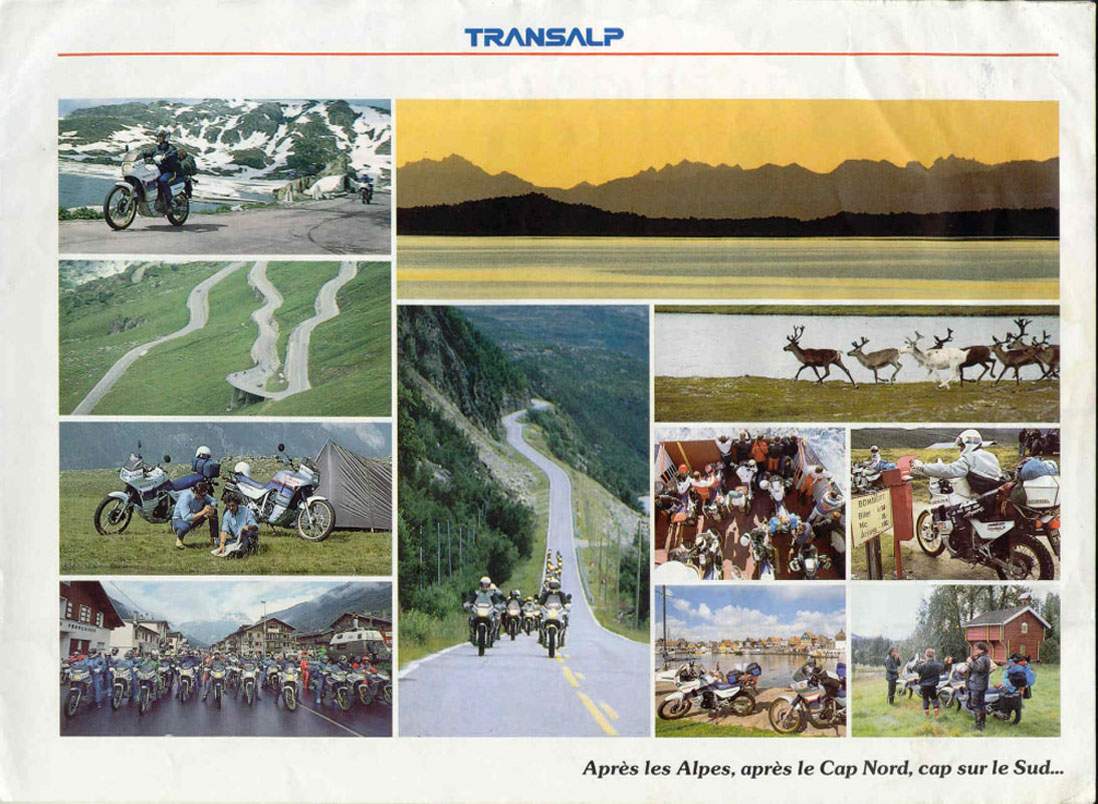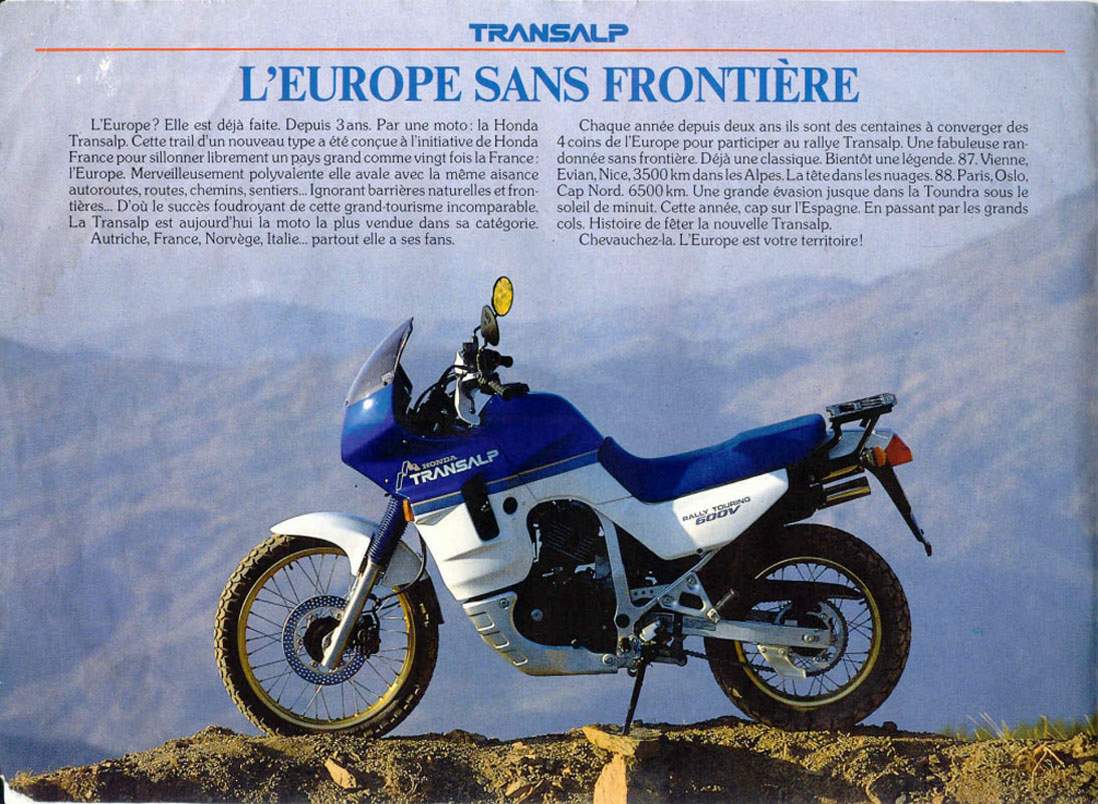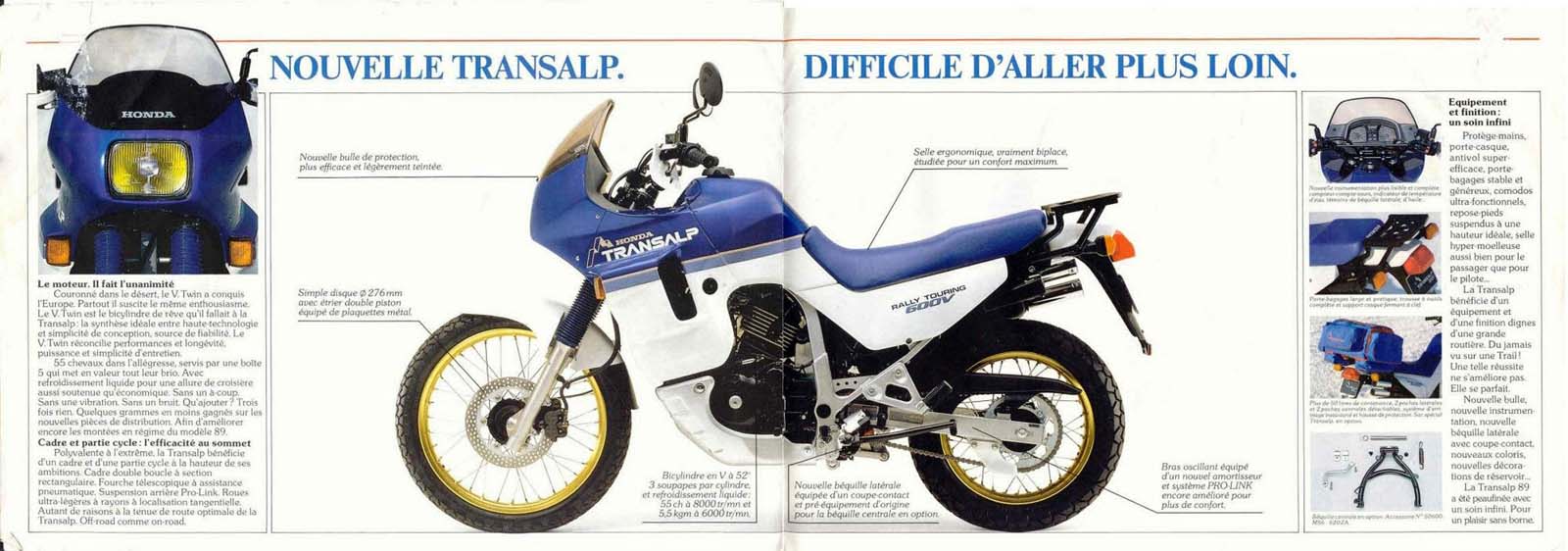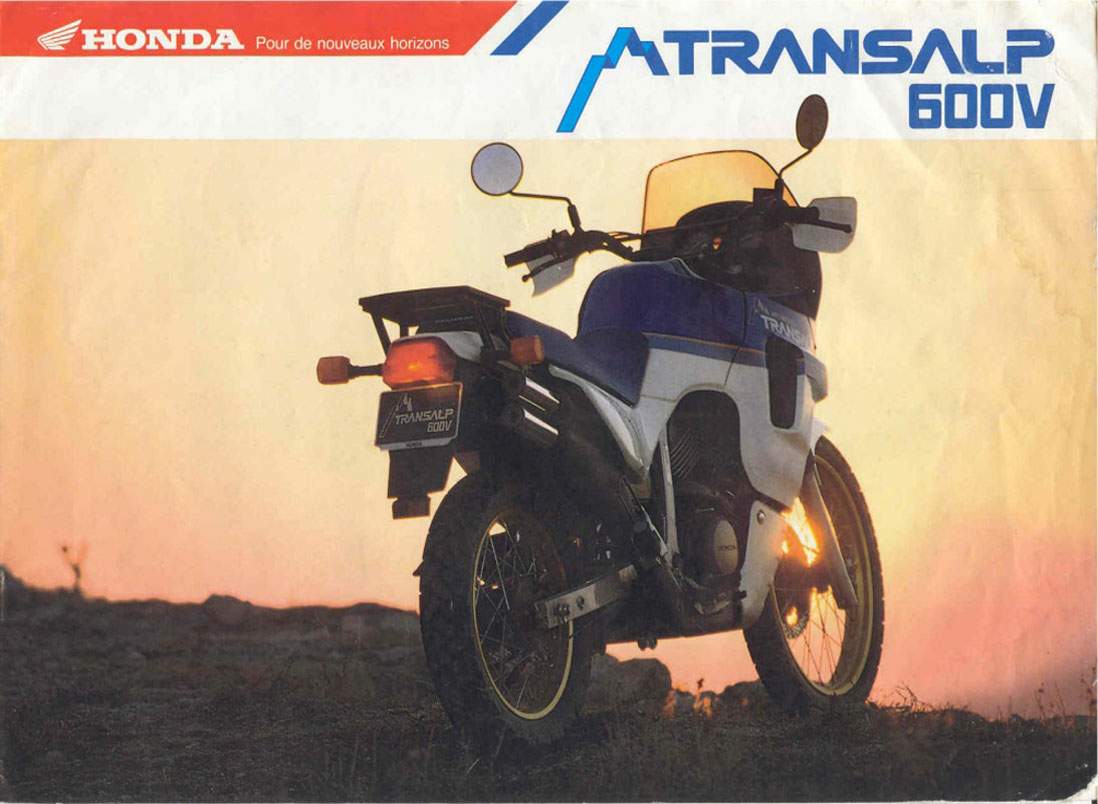
|
|
|
|
|
|
Classic Bikes
Custom Bikes
Individual
Racing Bikes AJP
AJS
Aprilia
Ariel
Avinton / Wakan
Bajaj
Benelli
Beta
Bimota
BMW
Brough Superior
BRP Cam-Am
BSA
Buell / EBR
Bultaco
Cagiva
Campagna
CCM
CF Moto
Combat Motors
Derbi
Deus
Ducati
Excelsior
GASGAS
Ghezzi Brian
Gilera
GIMA
Harley Davidson
Hero
Highland
Honda
Horex
Husaberg
Husqvarna
Hyosung
Indian
Jawa
Kawasaki
KTM
KYMCO
Laverda
Lazareth
Magni
Maico
Mash
Matchless
Mondial
Moto Guzzi
Moto Morini
MV Agusta
MZ / MuZ
NCR
Norton
NSU
Paton
Peugeot
Piaggio
Revival Cycles
Roland Sands
Royal Enfield
Sachs
Sherco
Sunbeam
Suzuki
SWM
SYM
Triumph
TVS
Ural
Velocette
Vespa
Victory
Vincent
VOR
Voxan
Vyrus
Walt Siegl
Walz
Wrenchmonkees
Wunderlich
XTR / Radical
Yamaha
Zero
Video
Technical
Complete Manufacturer List
|
Honda XL 600V Transalp
|
| . |
|
Make Model |
Honda XL 600V Transalp |
|
Year |
1990 |
|
Engine |
Four stroke, 52° V-Twin, SOHC, 3 valves per cylinder |
|
Capacity |
583 cc / 35.5 cu-in |
| Bore x Stroke | 75.0 x 66 mm |
| Cooling System | Liquid cooled |
| Compression Ratio | 9.2:1 |
|
Induction |
2x 32 mm Keihin Carburettor CV |
|
Ignition |
Electronic |
| Electrical | Electronical double CD-I ingnition, 12Vdc, 12V/12Ah battery, AC-generator, electrical starter, electronic safegard on side stand |
| Generator | 0.310 kW / 5000 rpm |
| Starting | Electric |
|
Max Power |
55 hp / 41 kW @ 8000 rpm |
|
Max Torque |
52.6 Nm / 38.8 ft-lb @ 6000 rpm |
|
Transmission |
5 Speed |
| Final Drive | Chain |
| Gear Ratio | 1st: 2.571 2nd: 1.777 3rd: 1.380 4th: 1.125 5th: 0.961 |
| Frame | Single downtube with double loop cradle of rectangular section |
|
Front Suspension |
41 mm Telescopic hydraulic forks |
| Front Wheel Travel | 200 mm / 7.8 in |
|
Rear Suspension |
Pro-link monoshock |
| Rear Wheel Travel | 187 mm / 7.4 in |
|
Front Brakes |
Single 276 mm disc |
|
Rear Brakes |
130 mm Drum |
|
Front Tyre |
90/90-21 54S |
|
Rear Tyre |
130/80-17 64S |
| Dimensions |
Length 2260 mm / 89.0 in Width 865 mm / 34.0 in Height 905 mm / 35.6 in |
| Wheelbase | 1505 mm / 59.2 in |
| Seat Height | 850 mm / 33.5 in |
| Ground Clearance | 200 mm / 7.9 in |
|
Dry Weight |
175 kg / 386 lbs |
| Wet Weight | 194 kg / 428 lbs |
|
Fuel Capacity |
18 Litres / 4.7 US gal |
|
Consumption Average |
18.3 km/lit |
|
Braking 60 - 0 / 100 - 0 |
13.3 m / 42.1 m |
|
Standing ¼ Mile |
13.4 sec / 152.8 km/h |
|
Top Speed |
172.5 km/h / 107 mph |
|
Road Test |
Adventure Group test Motosprint 1989 |
| . |
It seamed like the ideal bike to take to the Island. A big V-twin trail bike with a fairing, plenty of bottom-end grunt, a top end of around 100mph and enough room to carry two people and luggage with ease. Just the job to tackle the Isle of Ma: inviting trails, popping wheelies up and generally having a dual-purpose pose. Yes, for the 80th anniversary TT week, and Honda's 600V Transalp looked like being a perfect 'Rally Tourer' mount, with a little sportster thrown in.
Much is made in Honda's promotional blurb of the Transalp being a new concept in motorcycle design, and the term Rally Touring even ends up on the Transalp's side panels. Despite Honda's claims, the concept of a Rally Tourer (by which I suppose they mean a triple-purpose bike - street, trail and tourer) is far from new. The Italians and French have been converting big trailers into rally tourers for some years now, although it was BMW who really started it all off with the R80GS back in 1981. (Some would argue that BSA were the first with the Firebird, but basically all that was was a lightly modified A65 Thunderbolt so it doesn't count.)
The R80GS was basically a road bike turned trailer which sold better on the Continent than over here because the Continentals appreciate the idea of a big trailer with touring capabilities more than we do. In fact so many southern Europeans were putting big tanks, screens and luggage on their XT600s, and there was so much interest in the Paris-Dakar rally that Yamaha did the exact opposite to BMW (but with very similar results). They made a rally tourer out of a big trail bike - lo and behold, the XT600 Tenere. Then they sold 10,000 in six months in Europe alone, which was enough to spur the opposition into producing their own Paris-Dakar replicas. Honda came out with the XL600LM, Suzuki with the DR600 Dakar, and finally Kawasaki with the KLR650. Doubtless wary of the vagaries of Continental fashions, Honda have studiously avoided labeling the Transalp with any kind of P-D or desert name, sticking instead to the range of mountains at the heart of the Transalp-buyers' homelands. That's despite the fact that the Transalp actually looks more like a Paris-Dakar replica than any of the other replicas.
Having realised that most big trailers and P-D look-a-likes are used primarily for touring and posing, not serious dirt riding, Honda set about making the Transalp as an accomplished road bike as possible without sacrificing off-road capability. It was decided that the old XL600 motor was top long in the tooth (and a big single doesn't make for the most comfortable road bike), so their new Rally Tourer should be an in-line V-twin, just like their works P-D NRX780 machine. And it just so happened that the VT500 engine was a suitable candidate to be bored and stroked into a 600. There's actually more to it than that, because although similar in design - both use two small inlet valves and one larger exhaust valve per cylinder - there are significant differences. With the bore and stroke up to 75 by 66mm, the compression ratio is down to 9.2:1 (from 10.5:1) and the carb sizes are 2mm smaller at 32mm. More significantly, the Transalp uses five well-spaced ratios in the gearbox compared to the VT's six closer ratios to give it a easier, less frenetic feel. Like the VT, the powerplant is water-cooled and uses Honda's clever off-set crank-pin arrangement to reduce the vibes that go with a narrow-angle V-twin.

The power and torque outputs of the Transalp are also similar to the VT except that the Transalp make more power earlier and doesn't hold peak power (which occurs at 6500rpm, 2500 before the red line) as long: It also has more torque than the VT, but again the torque curve is very similar to that of the VT -nice and flat.
On the road the Honda's motor is a real gem, but like any real gem it does have its flaws. From 2000rpm it produces gobs of torque and will pull cleanly and briskly from below those revs in any gear right up to the red line. The problem comes at just over 6000rpm, because above that the engine begins to vibrate badly and sends wicked vibes through the footrests. You don't notice the vibes through the handlebars as they're rubber-mounted, nor through the firm, but well-padded seat. The vibrations just send your feet to sleep after 20 minutes at over 6000rpm. On an alleged tourer this isn't too clever because, depending on your vibration pain threshold, it rules out speeds above 75mph. Which is a shame as the fairing will allow you to maintain a steady 90mph on the motorway no problem.
I actually found on the 270-mile run up to Heysham that if you dangle your feet limply off the footrests you don't notice that your feet have gone to sleep until you stop for petrol and can't tell whether you've got your feet on the ground or not. This technique, while far from satisfactory, at least enables you to bop along at around 85mph without suffering unduly.
What makes any big trail bike such a good potential touring mount, apart from the straight-backed riding position, is the long-travel suspension...the Transalp is no exception. With nearly eight inches of fork travel at the front and seven-and-a-half inches at the back end the Transalp is certainly endowed with more than enough suspension movement to cope with two people and luggage over even the most spine-jarring potholes. The forks necessarily on the soft side without being so squidgy as to bottom out when you're hard on the front stopper, and the rear Pro-Link monoshock has adjustable preload via a ridiculously inaccessible threaded collar and keeps the ride smooth and not too bouncy.

Over on The Island the Transalp's suspension proved more than a match for the bumpy circuit and even cranking it hard left over the bumps at Ginger Hall failed to precipitate any nasty shakes or weaves - we just sort of undulated round the outside of a wildly shaking GPZ600. Although there's no way the Transalp can be considered a sportster, I was pleasantly surprised by its turn of speed and sure-footedness over the greatest race circuit in the world. We went out two-up on Mad Sunday morning for a quick lap before things got too crowded and frantic and were very surprised by the Transalp's performance. Julian had come back from the launch of the Transalp (and CBRs) spouting tales of Transalp's blitzing CBRs through Suzuka's tighter corners, but the rest of us in this office never gave them much credence. Now I know different, because during one complete lap of the TT course only two bikes went past us - a GPZ900 and an RG500 - and the Transalp was really motoring. Revving it to eight grand in each gear soon gets you whistling along around the ton, even two-up, and the combination of a strong motor and excellent suspension makes it much more useable than many bigger road bikes. The high point of my Mad Sunday was coming out of Brandish right up the chuff of a Ducati Pantah 600, taking a tow in his slipstream down the hill, then doing him on braking before sticking it through on the inside at Hillberry. A beautifully executed manoeuvre though I say so myself, and one that illustrated the versatility of the Transalp.
What really sets the Transalp apart from the rest of the big trailers is what the Japanese term 'rider accommodations'. While bikes like the Tenere and KLR650 have little headlamp fairings Honda have gone all the way with the Transalp and fitted a full fairing that looks very similar to the works Paris-Dakar machine. This is neatly moulded into the tank and shrouds the front cylinder while at the bottom a separate sump 'bash plate' is in reality just an ABS extension of the fairing. The bulbous side-panels also mould into the tank and prevent the pillion's right leg from being scorched on the upswept two-into-one-into-two exhaust system. To complete rider protection there are also a pair of knuckle-protectors fitted.

Inside the fairing is a dashboard more comprehensive than on any other trailer, with decent-sized tacho, speedo and temperature gauge, along with the usual array of idiot lights found on road bikes. The only thing missing, which would have been useful on something that's supposed to be a Rally Tourer, is a clock. But you can't have everything I suppose.
Even though the fairing doesn't look like it's going to do much of a job keeping the elements off you, it's actually very effective. At first glance it looks too narrow, and the screen seems much too low, but once you're perched on the long, comfortable seat (a lengthy 34 and a half inches from the ground) and bopping along in the foul weather that enveloped the Isle of Man for most of TT week you actually stay pretty dry. At a smidge over six feet tall, the screen kept most of my upper body free of rain and I took all the wind blast on the chin piece of my helmet. The fairing's also wide enough to keep most of your arms and legs out of the worst of the rain and the knuckle-protectors do the same for your hands. The only bits to take a serious drenching were my feet (but they were numb already so that didn't really matter). All in all, the fairing's a damn impressive piece of kit - ten out ten for that.
Naught out of ten, however, for the Transalp's luggage-carrying capabilities. The day before I went off to The Island I bought some new throw-over panniers, packed them and a tank-bag, and then went out to load up the bike. Problem. You can't get any luggage on the Transalp. This is a bloody Rally Tourer and you can't get any kit on it! All that cods in the promotional leaflet about 'the world of touring with nights in the great outdoors' is all very well, but you'll never live to enjoy 'the calls of the birds, the babbling of the brook and the ever-changing patterns of clouds' because without any space to pack a tent and a sleeping bag you will have expired from hypothermia half way through the night.
The basic problem is that the upswept exhausts preclude the use of throw-over panniers and the shape of the tank and fairing make it impossible to fit a normal tank-bag. This just leaves the rather small carrier rack on which to put all the necessary gear for two people for a week. The next problem is that any bag big enough to take that much gear also takes up half the pillion seat and weighs enough to seriously upset the Transalp's handling. This constitutes a major cock-up on the design front because if Honda are selling this on the Rally Touring tag it should have more luggage capacity than a DB1.

On the Rally side of things (by which 1 suppose they mean it's got limited off-road capabilities) the Transalp scores slightly better. 1 didn't do a whole lot of off-road riding, and with the fairing costing around £300 to replace I don't suppose many other owners will either, but negotiating an occasional dirt track and boggy camp site was easier than I thought it'd be. The tyres are a curious mixture of road and trail (semi-knoblies) but gripped well until the going got really soft. With all that weight (Honda claim 3831b dry, but I'm sure it weighs a hell of a lot more than that) it's a real handful for all but the most experienced trail riders. I certainly won't be doing the Land's End Trial on one next year, even though the power delivery and low-down torque should make for a good trail iron.
All in all the Transalp is a good motorcycle, not an excellent one but good all the same. It comes closest of any bike so far to being a true all-rounder but it still has some very annoying faults. The high-speed vibrations can be debilitating after a while and the lack of luggage carrying capacity is the major blot on the Transalp's copybook. There are other niggling faults, such as a feeble headlight beam and an engine that's fiddly to work on, but these are more than overshadowed by the overall excellence of its engine, fairing, suspension and handling. The Paris-Dakar styling may not be to everyone's taste but I find it very pleasing. As a day-to-day bike for the single man (or woman with long legs) it's hard to beat, but as a Rally Touring machine...well, six out of ten, must try harder.
Source Motorcycle International 1987

|
Any corrections or more information on these motorcycles will be kindly appreciated. |